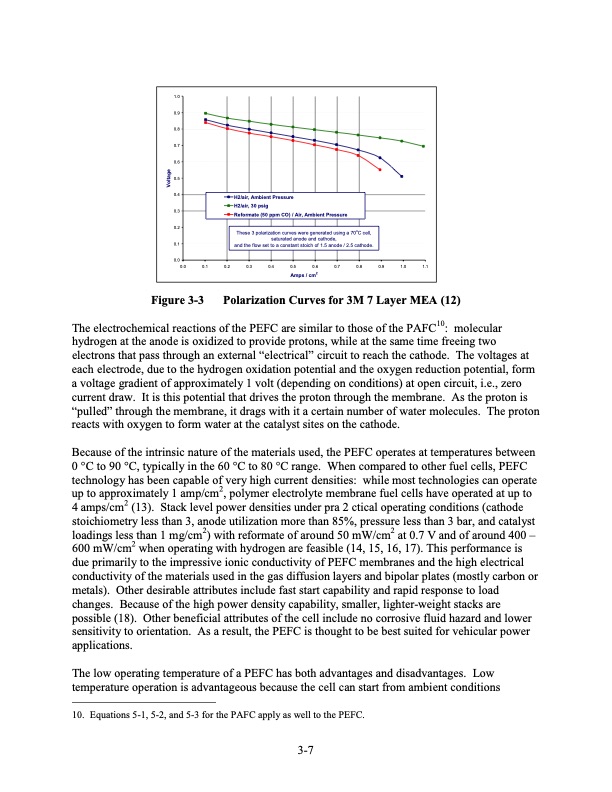
PDF Publication Title:
Text from PDF Page: 094
1.0 0.9 0.8 0.7 0.6 0.5 0.4 0.3 0.2 0.1 0.0 H2/air, Ambient H2/air, 30 psig and th e flow set t Pressure Reformate (50 ppm CO) / Air, Ambient Pressure These 3 polarization curves were generated using a 70oC cell, saturated anode and cathode, o a const ant stoich of 1.5 ano de / 2.5 ca thode. 0.0 0.1 0.2 0.3 0.4 0.5 0.6 0.7 Amps / cm2 0.8 0.9 1.0 1.1 Figure 3-3 Polarization Curves for 3M 7 Layer MEA (12) The electrochemical reactions of the PEFC are similar to those of the PAFC10: molecular hydrogen at the anode is oxidized to provide protons, while at the same time freeing two electrons that pass through an external “electrical” circuit to reach the cathode. The voltages at each electrode, due to the hydrogen oxidation potential and the oxygen reduction potential, form a voltage gradient of approximately 1 volt (depending on conditions) at open circuit, i.e., zero current draw. It is this potential that drives the proton through the membrane. As the proton is “pulled” through the membrane, it drags with it a certain number of water molecules. The proton reacts with oxygen to form water at the catalyst sites on the cathode. Because of the intrinsic nature of the materials used, the PEFC operates at temperatures between 0 °C to 90 °C, typically in the 60 °C to 80 °C range. When compared to other fuel cells, PEFC technology has been capable of very high current densities: while most technologies can operate up to approximately 1 amp/cm2, polymer electrolyte membrane fuel cells have operated at up to 4 amps/cm2 (13). Stack level power densities under pra 2 ctical operating conditions (cathode stoichiometry less than 3, anode utilization more than 85%, pressure less than 3 bar, and catalyst loadings less than 1 mg/cm2) with reformate of around 50 mW/cm2 at 0.7 V and of around 400 – 600 mW/cm2 when operating with hydrogen are feasible (14, 15, 16, 17). This performance is due primarily to the impressive ionic conductivity of PEFC membranes and the high electrical conductivity of the materials used in the gas diffusion layers and bipolar plates (mostly carbon or metals). Other desirable attributes include fast start capability and rapid response to load changes. Because of the high power density capability, smaller, lighter-weight stacks are possible (18). Other beneficial attributes of the cell include no corrosive fluid hazard and lower sensitivity to orientation. As a result, the PEFC is thought to be best suited for vehicular power applications. The low operating temperature of a PEFC has both advantages and disadvantages. Low temperature operation is advantageous because the cell can start from ambient conditions 10. Equations 5-1, 5-2, and 5-3 for the PAFC apply as well to the PEFC. 3-7 VoltagePDF Image | Fuel Cell Handbook (Seventh Edition)

PDF Search Title:
Fuel Cell Handbook (Seventh Edition)Original File Name Searched:
fuel-cell-handbook.pdfDIY PDF Search: Google It | Yahoo | Bing
NFT (Non Fungible Token): Buy our tech, design, development or system NFT and become part of our tech NFT network... More Info
IT XR Project Redstone NFT Available for Sale: NFT for high tech turbine design with one part 3D printed counter-rotating energy turbine. Be part of the future with this NFT. Can be bought and sold but only one design NFT exists. Royalties go to the developer (Infinity) to keep enhancing design and applications... More Info
Infinity Turbine IT XR Project Redstone Design: NFT for sale... NFT for high tech turbine design with one part 3D printed counter-rotating energy turbine. Includes all rights to this turbine design, including license for Fluid Handling Block I and II for the turbine assembly and housing. The NFT includes the blueprints (cad/cam), revenue streams, and all future development of the IT XR Project Redstone... More Info
Infinity Turbine ROT Radial Outflow Turbine 24 Design and Worldwide Rights: NFT for sale... NFT for the ROT 24 energy turbine. Be part of the future with this NFT. This design can be bought and sold but only one design NFT exists. You may manufacture the unit, or get the revenues from its sale from Infinity Turbine. Royalties go to the developer (Infinity) to keep enhancing design and applications... More Info
Infinity Supercritical CO2 10 Liter Extractor Design and Worldwide Rights: The Infinity Supercritical 10L CO2 extractor is for botanical oil extraction, which is rich in terpenes and can produce shelf ready full spectrum oil. With over 5 years of development, this industry leader mature extractor machine has been sold since 2015 and is part of many profitable businesses. The process can also be used for electrowinning, e-waste recycling, and lithium battery recycling, gold mining electronic wastes, precious metals. CO2 can also be used in a reverse fuel cell with nafion to make a gas-to-liquids fuel, such as methanol, ethanol and butanol or ethylene. Supercritical CO2 has also been used for treating nafion to make it more effective catalyst. This NFT is for the purchase of worldwide rights which includes the design. More Info
NFT (Non Fungible Token): Buy our tech, design, development or system NFT and become part of our tech NFT network... More Info
Infinity Turbine Products: Special for this month, any plans are $10,000 for complete Cad/Cam blueprints. License is for one build. Try before you buy a production license. May pay by Bitcoin or other Crypto. Products Page... More Info
| CONTACT TEL: 608-238-6001 Email: greg@infinityturbine.com | RSS | AMP |